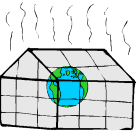

Greenhouse Effect
 The Sun is the only source of external heat for the Earth. Sunlight heats the Earth's surface during the day. As the Earth's surface warms up it also releases heat, but we cannot see this as light like sunlight from the Sun. Sometimes, on hot days we can see the heat shimmers rising from a hot black road. This shows us that a lot of heat is being given off by the surface. At night, when the surface is no longer heated by the Sun, the Earth continues to give off heat in this way. In fact, at the scale of the whole Earth, as much heat is given off by the Earth as is received by the Sun. This keeps the average temperature of the Earth fairly stable, currently at about 15°C.
The Sun is the only source of external heat for the Earth. Sunlight heats the Earth's surface during the day. As the Earth's surface warms up it also releases heat, but we cannot see this as light like sunlight from the Sun. Sometimes, on hot days we can see the heat shimmers rising from a hot black road. This shows us that a lot of heat is being given off by the surface. At night, when the surface is no longer heated by the Sun, the Earth continues to give off heat in this way. In fact, at the scale of the whole Earth, as much heat is given off by the Earth as is received by the Sun. This keeps the average temperature of the Earth fairly stable, currently at about 15°C.
If the Earth didn't have an atmosphere, its surface would on average be as cold as the surface of the Moon, about -18°C. The reason that it is much warmer is because of greenhouse gases in the air. Greenhouse gases exist naturally in air, heating it by trapping energy that has originally come from the Sun. This process is called the greenhouse effect.
In the last 200 years mankind has disturbed the natural greenhouse effect by increasing the amount of greenhouse gases in the atmosphere. Scientists call this the "enhanced greenhouse effect". This is trapping more heat and may be causing global warming.
 | Greenhouse effect |
Websites
Other topics Technical Page
Technical Page
• DETR
• Schools Database
• Schools Database
• US EPA
• Introduction
• 20th Century
• 21st Century
• British Isles
• Climate Change
• Doing Our Bit
• Extreme Weather
• Greenhouse Effect
• Greenhouse Gases
• Impacts
• Sea Level
 Print Topic
Print Topic